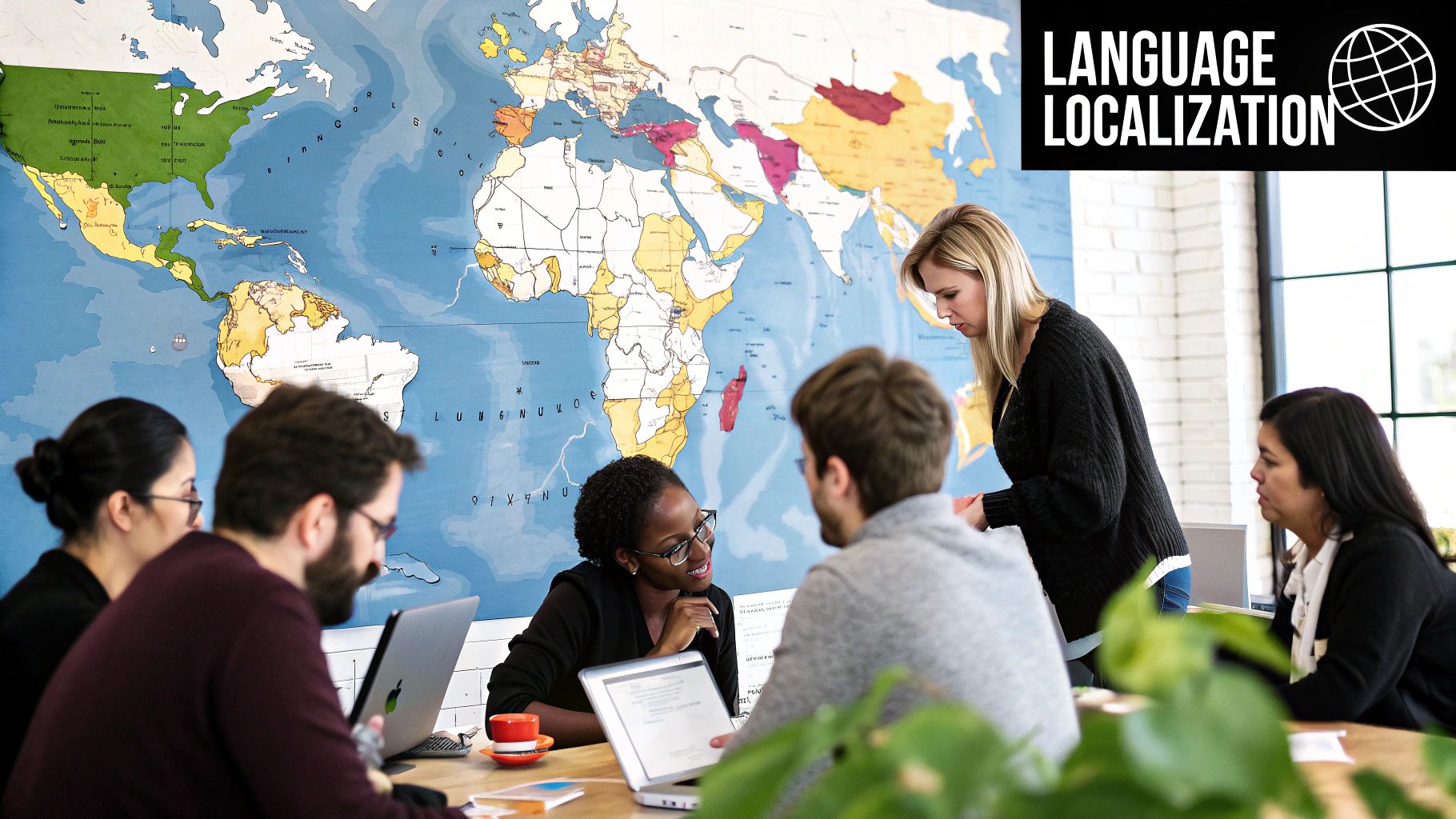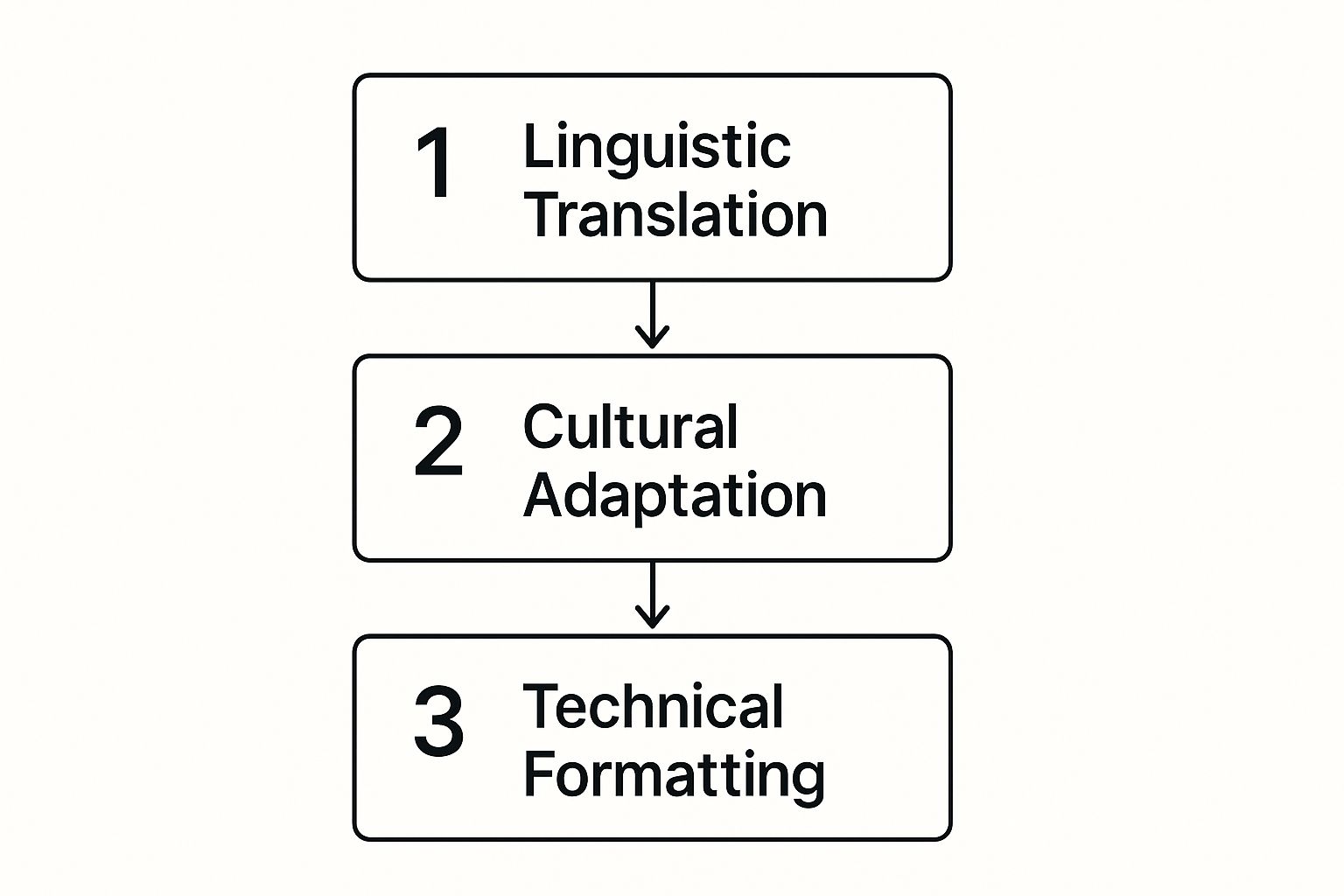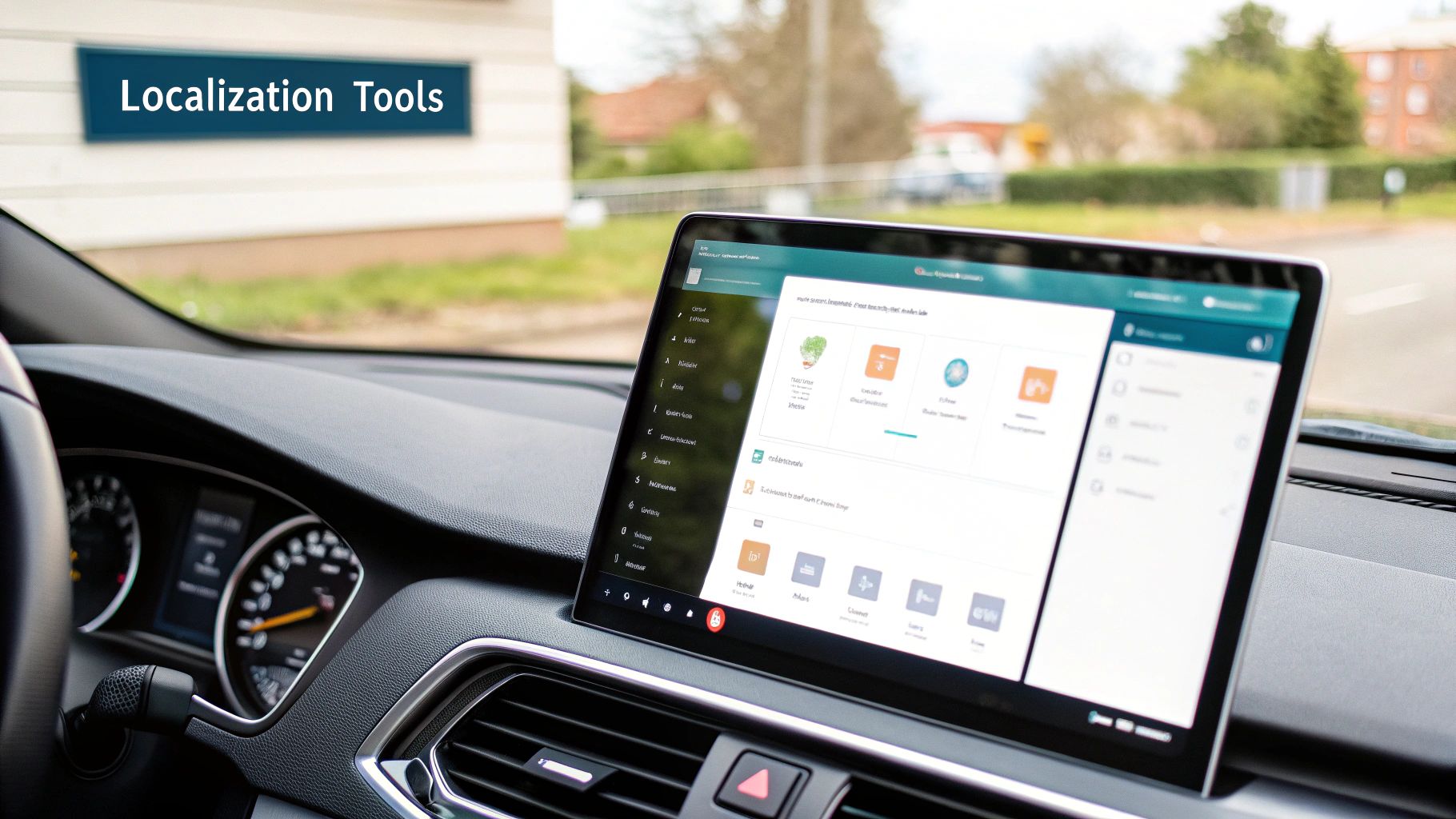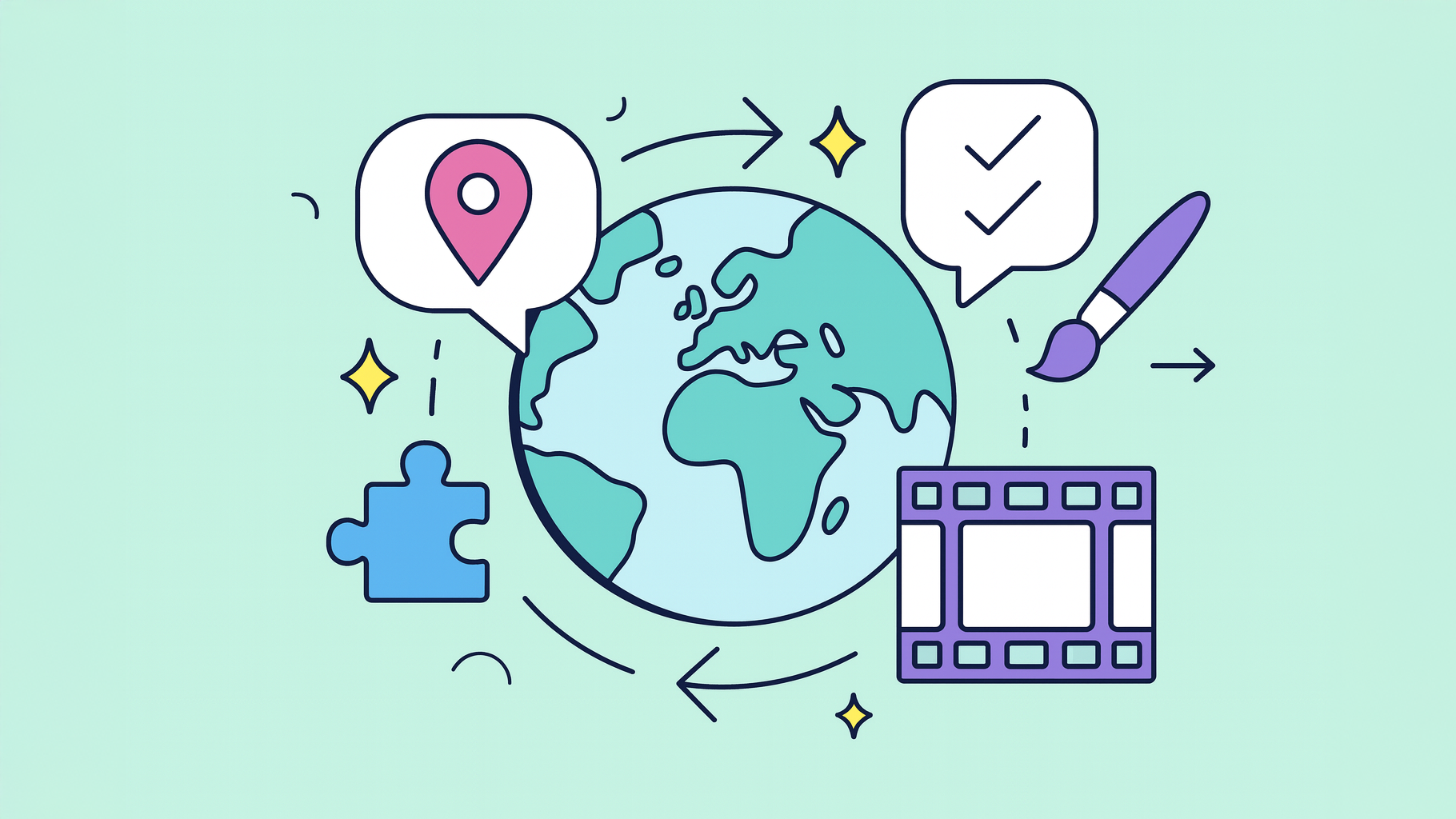Language localization is the process of taking your content, product, or service and truly adapting it for a specific local market, covering both its language and culture. It’s so much more than a simple word-for-word translation. The real magic happens when your message feels truly native and builds instant trust with a new audience.
Going Beyond Words to Win Global Audiences

Think of it this way: a direct translation is like watching a foreign film with subtitles. You get the plot, but you miss all the cultural inside jokes and subtle references that make it great. Real localization is like a full remake of that film—they recast the actors, rewrite the jokes, and even tweak the storyline so it hits home for the local audience.
This is the heart of language localization. It’s about transforming something foreign into an experience that feels completely familiar.
Translation vs. Localization at a Glance
It’s easy to confuse these two terms, but they represent very different levels of effort and impact. Translation is about swapping words, while localization is about swapping entire cultural contexts.
Here’s a quick breakdown of how they stack up:
| Aspect | Translation | Localization |
|---|---|---|
| Primary Goal | Convert text from one language to another | Adapt the entire user experience for a new culture |
| Scope | Words and grammar | Words, images, colors, formats, cultural norms |
| Process | A one-step linguistic task | A multi-faceted strategic process |
| Outcome | The content is understood | The content feels native and resonates emotionally |
| Example | Translating “Add to Cart” | Changing a US dollar sign ($) to a Euro sign (€) and updating product photos |
While translation is a crucial part of the process, localization is what truly connects your brand with a global audience on a deeper level.
Adapting More Than Just Language
This kind of deep cultural adaptation is a thoughtful process. It means looking at every single element of your content to make sure it feels natural and right for the target market.
A solid localization strategy has to consider several key areas:
- Cultural Nuances: This involves adjusting everything from humor and social etiquette to the hand gestures used in your images to align with what’s expected locally.
- Visuals and Symbols: You might need to change colors, icons, and graphics that carry different meanings or could even be offensive in another culture.
- Formats and Layout: This covers the nitty-gritty details like switching date formats (DD/MM/YYYY vs. MM/DD/YYYY), currencies, units of measurement, and even flipping the entire layout for right-to-left languages like Arabic.
The real goal here is to get rid of any friction that makes your brand feel like an outsider. When you get localization right, you build trust and create genuine connections. You make your international customers feel seen and valued.
This process ensures your message isn’t just understood—it feels right. By investing in this deeper level of adaptation, brands can walk into new markets with confidence and build a loyal following. For a more detailed look, check out our complete guide on what is language localization.
Ultimately, localization is an act of empathy. It’s about understanding that different cultures see the world in their own unique ways and showing respect for those differences in how you do business.
Why Localization Is Your Strongest Growth Lever

Let’s be honest: in a packed global market, just being understood isn’t going to cut it. If you want to actually win over new markets, you have to connect with people on their own turf, in a way that feels natural to them. This is where language localization stops being a “nice-to-have” and becomes your most powerful tool for growth.
When you take the time to localize, you’re sending a clear message. You’re showing customers that you see them, respect their culture, and understand their world. That builds a kind of trust and loyalty that a generic, one-size-fits-all approach could never hope to achieve. Products and marketing that feel familiar just work better, boosting engagement and, ultimately, sales.
The Financial Impact of Cultural Connection
The business case for localization isn’t just a feel-good story; it’s written in hard numbers. When customers feel like a brand “gets” them, they’re far more likely to click “buy” and come back for more. This isn’t about a small bump in sales—it’s about unlocking entirely new, sustainable revenue streams.
The numbers speak for themselves. The global localization industry is a heavyweight, with a market size valued at $71.7 billion and on track to hit $75.7 billion. That’s not a niche market; it’s a fundamental part of how modern business gets done.
This explosive growth proves a simple truth: brands that invest in genuine cultural connection don’t just compete—they dominate.
When your brand speaks a customer’s language—both linguistically and culturally—you aren’t just selling a product. You are building a relationship, which is the most valuable asset for long-term international growth.
The return on that investment shows up in a few key ways:
- Increased Market Share: Stepping into a new country with content that truly resonates gives you a day-one advantage over the competition.
- Higher Customer Satisfaction: Think about it. When a help portal or support chat feels like it was made for you—like with a multilingual service desk—satisfaction scores naturally go up.
- Improved Brand Perception: A well-localized experience paints you as a smart, global-minded company, which does wonders for your brand’s reputation everywhere.
At the end of the day, localization is one of the smartest bets you can make for real international growth. To see how this plays out in the real world, check out the insights from an automatic translation report for business.
Your Roadmap to a Successful Localization Project
So, how does a language localization project actually get off the ground? Diving in without a clear plan can feel overwhelming, but with the right structure, it becomes a surprisingly manageable—and highly effective—process. To really succeed in global markets, every project needs a solid roadmap, including a comprehensive content localization strategy.
This journey usually kicks off with some deep cultural research and content analysis to figure out what needs to change. From there, it’s all about the hands-on work of making linguistic and technical adjustments. The goal is to make sure every single element, from a single word to the entire user interface, feels completely natural to your new audience.
The infographic below breaks down the core stages of this transformation.

As you can see, successful localization is a three-part process. Direct translation is just the start, followed by the absolutely critical steps of cultural and technical adaptation.
Assembling Your Core Localization Kit
A huge part of this roadmap is putting together a localization kit. Think of it as a collection of essential documents that guides your team and keeps your brand’s voice powerful and consistent, no matter the market. It’s the single source of truth for everyone involved.
Your kit should include:
- Style Guides: These documents spell out your brand’s tone, voice, and stylistic preferences. They tell linguists whether to be formal or casual, witty or serious, making sure your brand personality always shines through.
- Terminology Glossaries: A glossary is simply a list of key terms and their pre-approved translations. This is a lifesaver for preventing inconsistencies, especially with industry-specific jargon or branded feature names.
- Cultural Playbooks: These guides are your cheat sheets for each target market, outlining key cultural norms, sensitive topics to steer clear of, and what kind of imagery works best.
A well-prepared localization kit is your project’s most valuable asset. It drastically reduces errors, speeds up the workflow, and empowers linguists to make smart, on-brand decisions without constant back-and-forth.
Ultimately, this structured approach—combining a clear process with robust documentation—is what separates a messy, haphazard effort from a successful global launch. It gives your entire team, from talented linguists to technical engineers, the framework they need to collaborate effectively and deliver a flawless final product.
How Tech Is Changing the Localization Game
Not long ago, localization was a painful, manual grind. Think endless email threads, translators juggling multiple spreadsheets, and a frustratingly slow pace. Thankfully, those days are fading fast.
Today, technology has completely flipped the script. Smart teams are now using a powerful mix of artificial intelligence and specialized software to take their products global faster than ever before. It’s not about just working harder; it’s about working smarter.
The heart of this modern approach is the Translation Management System (TMS). A TMS is the central command center for everything related to localization. It automates tedious tasks, keeps all your translations organized, and ensures every piece of content stays consistent with your brand, no matter the language. To get a better sense of how this works on a broader scale, you can check out this guide on AI workflow automation.
The Rise of the Hybrid Model: MTPE
One of the biggest game-changers has been the hybrid model known as Machine Translation Post-Editing (MTPE). It’s a beautifully simple idea: let machines do what they’re good at, and let humans do what they’re good at.
Here’s how it works. First, AI-powered machine translation does the initial heavy lifting, translating huge amounts of text almost instantly. Then, a professional human editor steps in. They polish the output, refining the tone, ensuring cultural nuances are spot-on, and making sure it perfectly reflects the brand’s voice.
This blend gives you the best of both worlds:
- Speed: You can translate massive volumes of content in a fraction of the time.
- Quality: The final translation is culturally appropriate and high-quality, thanks to the human touch.
- Cost-Savings: It dramatically cuts down on the manual effort needed from professional linguists, making the whole process more affordable.
MTPE isn’t about replacing human experts. It’s about empowering them. By letting technology handle the grunt work, linguists can focus their energy on what truly matters: making sure the message resonates deeply with a local audience.
This tech-driven shift isn’t just a niche trend; it’s fueling massive growth. The language services market is projected to jump from $78.12 billion to $131.75 billion by 2033, largely because of these innovations. For any company serious about growing globally, this is the new standard.
And if you’re curious about just how far machine translation has come, you might be surprised to see the results of our experiment asking whether Google Translate can pass the Turing Test. The answer is pretty revealing.
See How Localization Drives Success in B2B Tech
Theory is one thing, but seeing localization in action really makes the concept click. Let’s look at a real-world example using a complex B2B platform most of us know: Jira Service Management. This is where localization isn’t just a “nice-to-have”—it’s mission-critical for serving international customers and empowering global teams.
Picture a support agent in Berlin, working through her day entirely in German. She’s tackling a ticket from a customer in Japan, who sees every single prompt, field, and notification in Japanese. That seamless, behind-the-scenes experience is localization, and it’s what allows software to thrive on a global scale.
Here’s a quick look at the Jira Service Management interface. It can be configured for dozens of languages, giving users worldwide a truly native feel.

This immediately reduces the mental gymnastics for non-English speakers, which is a huge win for productivity and getting teams to actually use the software.
Core Elements of Service Desk Localization
For a tool like Jira, great localization goes way beyond just translating the main interface. It means adapting every single touchpoint to create a support experience with zero friction.
The key components that absolutely must be localized include:
- User Interface (UI): Every button, menu, and setting needs to be translated and feel culturally natural.
- Knowledge Base Articles: Self-service is king. Making support articles available in multiple languages lets users find their own answers, fast.
- Automated Notifications: Customers should get email alerts and status updates in their preferred language, not a foreign one.
- Customer Portal: The entire front door where users submit requests has to be fully localized.
This is what separates basic translation from true, thoughtful localization. By building a fully immersive environment, companies boost customer satisfaction, slash resolution times, and make their operations run a whole lot smoother.
This same thinking applies to automated support, too. For example, some companies have seen response times drop by as much as 65% just by localizing their chatbots to handle languages like Bahasa Indonesia and Thai.
Digging into specific use cases for a multilingual service desk in Jira really shows how deeply localization can be woven into day-to-day B2B operations.
Your Language Localization Questions Answered
Dipping your toes into global markets can feel like opening a can of worms. As soon as you start thinking about adapting your products and content, a ton of questions pop up. It’s totally normal to run into the same points of confusion as everyone else.
Let’s clear the air and tackle some of the most common questions about what language localization really is and how it actually works. Getting these fundamentals right is the first step to building a strategy that doesn’t just tick a box but genuinely drives results.
How Is Localization Different from Internationalization?
This is easily the most common question, and getting the difference is crucial.
Think of it like building a house. Internationalization (i18n) is all the architectural work you do upfront. You’re installing universal power outlets and making sure the wiring can handle different voltages. You’re designing the house so it can be adapted for anyone, no matter where they’re from.
Localization (l10n), on the other hand, is when you decorate the house for a specific resident. It’s plugging a lamp with the right local plug into one of those universal outlets so it works perfectly. Internationalization is the one-time prep work; localization is the market-specific tweaking you’ll do over and over again.
Can I Just Use AI for My Localization Needs?
Look, AI-powered machine translation is a fantastic tool for getting things done fast and at scale. But it has its limits. For high-stakes content—your main user interface, critical legal documents, or the marketing copy you’ve spent weeks perfecting—relying solely on a machine is a gamble.
AI can easily trip over subtle cultural nuances, leading to cringey phrasing or, even worse, mistakes that can seriously damage your brand’s reputation.
The smartest approach is a hybrid one: Machine Translation Post-Editing (MTPE). An AI does the heavy lifting with a quick, first-pass translation. Then, a professional human linguist steps in to polish it, ensuring the tone, quality, and cultural accuracy are spot-on. You get the best of both worlds: speed and quality.
How Much Does Language Localization Cost?
There’s no simple answer here. The cost of localization is completely tied to the scope of your project.
A few key factors will move the price tag up or down:
- Target Languages: Some languages are simply more expensive to translate because there are fewer skilled linguists available.
- Content Volume: Most providers charge by the word. So, localizing a single landing page is going to be a lot cheaper than overhauling your entire software application.
- Content Complexity: Highly technical or creative content demands specialized expertise and more time, which naturally increases the cost.
Instead of seeing it as just another expense, think of it as an investment. When done right, localization directly unlocks new revenue streams in markets you couldn’t otherwise dream of reaching.
What Is the First Step to Start Localizing?
The absolute best place to start is with a localization audit. Before you even think about translating a single word, you need to analyze your potential markets. Which languages offer the highest potential return on your investment? Where is the demand for your product already simmering?
At the same time, you’ll want to review your content, code, and design to see if they’re ready for adaptation—this is basically your internationalization check-up. Kicking things off with a clear strategy and a single pilot language is almost always more effective than trying to conquer the whole world at once.
And for teams juggling complex projects, a good project management tool can be a lifesaver for keeping everyone on the same page. In fact, many teams use a Jira stand-up app to keep everyone aligned and boost efficiency across different initiatives.
resolution Reichert Network Solutions GmbH can help you start your localization journey with Issue Translation for JSM.
